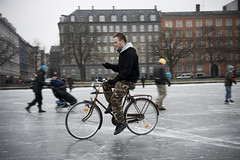
Budapest public transport workers
went on strike this morning, leading to the predictable traffic jams and opportunistic truancies among city workers. I myself am working at home today. Although it's a limited strike, creating a slow down rather than a freeze at the BKV transport company, this morning's long trek to my son's daycare persuaded me that it'll be best to avoid cross-town travel.
In Budapest, public transport commands a 55 percent modal share, which means a transit strike can have devastating consequences. However, transport cycling advocates anticipate these events with perverse glee because they force people to consider, and try out, alternative means of transport.
Naturally, most people who take up cycling as a way to cope with a transit strike will go back to their regular means of transport once the crisis subsides. But under certain conditions cycling gains can be locked in. It all depends on what kind of experience the crisis cyclists have during their two-wheeled foray around the city. A text book example occurred in Paris in 1996 when public transport workers went on a strike for a month. Rush-hour traffic in Paris is awful under normal conditions, but with the metro shut down, the city's boulevards froze solid. Many people who tried to use cars to get to work found themselves stuck in traffic for hours on end. With cars an unrealistic option, commuters began to bike, walk and, being Parisians, roller-blade.
Serendipitously, Paris's new mayor had just launched an ambitious programme to encourage transport cycling in the city. Bike paths were being built and cycling NGOs were working at fever pitch to promote their cause. When the strike was over, they were prepared with a publicity campaign about planned cycling developments to encourage strike cyclist to stick with their bikes. In the years since, cycling levels in Paris have jumped dramatically -- and advocates credit the transit strike for providing that first spark.
Similarly, a public transit strike here in Budpest in April of 2008 is credited with accelerating a rise in cycling levels that began circa 2004 with the first big Critical Mass rides. Who knows how much it contributed, but at the time the Kerekagy blog reported
record numbers of cyclists in the city.

It must be said that one of the contributing factors to the big cycling numbers during the 2008 strike was the pleasant spring weather. By contrast, the kick-off of this latest strike coincided with a major drop in temperature. Until a day or two ago, we were having unseasonably mild temperatures in the mid-teens (Celcius), but this morning it was below freezing.
Despite that, I noticed a few newcomer cyclists along with the usual hardcore winter riders when I got out this morning. On my way up Romer Floris utca, the steep street leading to Lance's day care, I normally see just one other cyclist -- it's a pretty steep street, and therefore, not a favoured bike route. But this morning, I spotted three others. On Margit körút, there were several cyclists riding on the sidewalks: newcomer, strike cyclists, I figured. The usual winter riders are hard-core types who ride with car traffic on the carriageway.
The main impact on traffic, however, was not a rise in cycling levels but rather a rise in car traffic (bad) and foot traffic (still good).


The increase in foot traffic was especially noticeable on Margit bridge. Normally the 4-6 tram is the quickest way across the span (with a major renovation going on, private passenger cars are banned). The 4-6 carries more than 300 people at a time and during normal operations it departs about every 2-3 minutes during rush hour. But this morning people had to wait up to 10 minutes. Perhaps because of the cold weather, a huge number of people chose to hoof it instead. Nothing like a brisk walk to ward off the chills.













